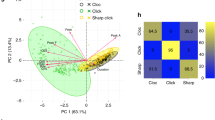Abstract
FOR, decades, this area of excessively thin, ‘Cellophane’-like cuticle of the tegmen of tettigonioids (Fig. 1) has been regarded as important acoustically—for example, Pierce1, who went so far as to calculate a resonant frequency for it on the assumptions that it is: (a) circular, (b) clamped peripherally and (c) made of material the relevant physics of which is that of ‘Pyroxylin’ plastic; he obtained good agreement between calculated and experimental figures, which could be interpreted as supporting the hypothesis2, but could equally well mean that the choice of ‘Pyroxylin’ was a fortunate one, since there is no evidence that the tegminal material resembles it in anything but appearance. Assumptions (a) and (b) are also of doubtful validity, and for some years I have doubted whether the mirror has any major acoustic importance; Dumortier3 expresses similar doubts. It could function acoustically in any of several ways, some of which are mentioned by Dumortier: (1) as a narrow-band resonator, tuned like a drum; (2) as a general sounding-board or acoustic coupler (belly of violin, loudspeaker diaphragm); (3) as a tymbal, actively buckling to and fro like that of a cicada. On the other hand, considering its high gloss, it could give a visual signal, especially perhaps in darkness, enabling the searching female, once she reaches close quarters, to locate the dorsum of the male on which she has to climb for copulation.
This is a preview of subscription content, access via your institution
Access options
Subscribe to this journal
Receive 51 print issues and online access
$199.00 per year
only $3.90 per issue
Buy this article
- Purchase on Springer Link
- Instant access to full article PDF
Prices may be subject to local taxes which are calculated during checkout
Similar content being viewed by others
References
Pierce, G. W., Songs of Insects (Cambridge, Mass., 1948).
Haskell, P. T., Insect Sounds (London, 1961).
Dumortier, B., in Acoustic Behaviour of Animals, edit. by Busnel, R. G. (Amsterdam) (in the press).
Pasquinelly, F., and Busnel, M. C., in L'Acoustique des Orthoptères, edit. by Busnel, B. G. (Paris, 1955).
Broughton, W. B., in Acoustic Behaviour of Animals, cited in ref. 3.
Haskell, P. T., in litt. (1953).
Author information
Authors and Affiliations
Rights and permissions
About this article
Cite this article
BROUGHTON, W. Function of the ‘Mirror’ in Tettigonioid Orthoptera. Nature 201, 949–950 (1964). https://doi.org/10.1038/201949a0
Issue Date:
DOI: https://doi.org/10.1038/201949a0
This article is cited by
-
Biophysik der Schallerzeugung durch die Vorderfl�gel der Grillen
Zeitschrift f�r Vergleichende Physiologie (1971)
-
Die Verst�ndigung durch Stridulationssignale bei Blattschneiderameisen
Zeitschrift f�r Vergleichende Physiologie (1968)
-
Further Investigations into the Function of the “Mirror” in Tettigonioidea (Orthoptera)
Nature (1967)
Comments
By submitting a comment you agree to abide by our Terms and Community Guidelines. If you find something abusive or that does not comply with our terms or guidelines please flag it as inappropriate.



